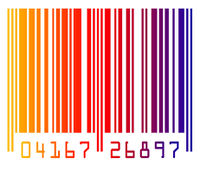Bar codes
Dan Tobias (Talk | contribs) m |
Dan Tobias (Talk | contribs) |
||
| Line 11: | Line 11: | ||
*[[3-DI]] | *[[3-DI]] | ||
*[[ArrayTag]] | *[[ArrayTag]] | ||
| + | *[[Australian Post Standard Customer]] | ||
*[[Aztec Code]] | *[[Aztec Code]] | ||
*[[Codabar]] | *[[Codabar]] | ||
| Line 29: | Line 30: | ||
*[[CyberCode]] | *[[CyberCode]] | ||
*[[d-touch]] | *[[d-touch]] | ||
| + | *[[DAFT]] | ||
*[[DataGlyph]] | *[[DataGlyph]] | ||
*[[Data Matrix]] | *[[Data Matrix]] | ||
| Line 34: | Line 36: | ||
*[[Dot code (Olympus)]] | *[[Dot code (Olympus)]] | ||
*[[Dot Code A]] | *[[Dot Code A]] | ||
| + | *[[DPD Barcode]] | ||
*[[DUN-14]] | *[[DUN-14]] | ||
*[[EAN-2]] | *[[EAN-2]] | ||
| Line 57: | Line 60: | ||
*[[JAN]] | *[[JAN]] | ||
*[[JAGTAG]] | *[[JAGTAG]] | ||
| + | *[[Japanese Postal Code]] | ||
| + | *[[KIX]] | ||
| + | *[[Korean Postal Authority Code]] | ||
*[[Latent image barcode]] | *[[Latent image barcode]] | ||
*[[MaxiCode]] | *[[MaxiCode]] | ||
| Line 75: | Line 81: | ||
*[[QuickMark Code]] | *[[QuickMark Code]] | ||
*[[QR code]] (Quick Response, used in marketing) | *[[QR code]] (Quick Response, used in marketing) | ||
| + | *[[Royal Mail 4-State]] | ||
*[[Secure Seal]] | *[[Secure Seal]] | ||
*[[SmartCode]] | *[[SmartCode]] | ||
Revision as of 21:47, 27 July 2013
Bar codes are used for a lot of purposes from product coding and inventory control to providing electronically-readable tags giving supplemental information such as web links related to a place or thing. The name tends to be used generically to cover all sorts of printed tags that can be read by machines, even if some don't actually have bars in them; they may have dots, squares, triangles, or other shapes instead. Some are "one-dimensional", read linearly; others are "two-dimensional" with a matrix of shapes. Some make use of color to distinguish elements, but most are monochrome and can be printed in any arbitrary color (usually black). A bar code format is known as a "symbology".
The 1979 comedy book The 80s: A Look Back, giving a fake "future history" of the 1980s, had fake bar codes (in a square format) on every page, parodying a belief that this sort of thing (proposed to be used in computer magazines to provide scannable program code) would go mainstream. The book also had an article "Adieu, Print" about the demise of print publishing, which was a few decades ahead of its time.
- 3-DI
- ArrayTag
- Australian Post Standard Customer
- Aztec Code
- Codabar
- Codablock F
- Code 1 (1A through 1H)
- Code 11
- Code 16K
- Code 25
- Code 39
- Code 49
- Code 93
- Code 128
- ColorCode
- Color Construct Code
- Compact Matrix Code
- CP Code
- CPC Binary
- CyberCode
- d-touch
- DAFT
- DataGlyph
- Data Matrix
- Datastrip Code
- Dot code (Olympus)
- Dot Code A
- DPD Barcode
- DUN-14
- EAN-2
- EAN-5
- EAN-8
- EAN-13 (used in place of UPC internationally and on books and medicines in the USA)
- EAN-14
- EZcode
- Facing Identification Mark
- Grid Matrix Code
- GS1-128
- GS1 DataBar
- Han Xin Code
- HD Barcode
- HIBC
- High Capacity Color Barcode
- HueCode
- INTACTA.CODE
- Intelligent Mail barcode
- InterCode
- Interleaved 2 of 5 (I 2/5)
- ITF-14
- JAN
- JAGTAG
- Japanese Postal Code
- KIX
- Korean Postal Authority Code
- Latent image barcode
- MaxiCode
- mCode
- MiniCode
- MMCC
- MSI
- Optar
- PaperDisk
- PDF417
- MicroPDF417
- PDMark
- Pharmacode
- Plessey
- PLANET
- PostBar
- POSTNET
- QuickMark Code
- QR code (Quick Response, used in marketing)
- Royal Mail 4-State
- Secure Seal
- SmartCode
- Snowflake Code
- ShotCode
- SPARQCode
- SuperCode
- RM4SCC
- Telepen
- Trillcode
- UltraCode
- UnisCode
- UPC-A (Universal Product Code)
- UPC-E (compact variety of UPC)
- VeriCode
- WaterCode
References
- Barcode (Wikipedia)
- Monmouthpedia, a Wikipedia project to put QR-coded signs all over the town of Monmouth, Wales linking to appropriate Wikipedia articles about local things
- Obituary of inventor of bar code
- Choosing the right barcode
